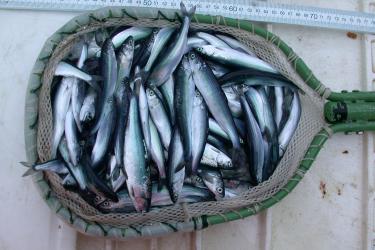We conduct our research across the 1.5 million mile span of Alaskan waters, providing data on seasonal fisheries, and developing environmental and biological indices of ecosystem health annually for resource management. Our field and laboratory research focuses on understanding the physical/chemical/biological interactions that influence how many fish survive to an age when they become available to the fishery (recruitment). These interactions affect the primary mechanisms that drive fisheries recruitment bottlenecks (the number of fish that survive the first year of life). Results are linked to ecosystem carrying capacity (how many organisms the ecosystem can support) and changes over time.
A strength of our work is the time period over which integrated observations have been conducted. We have been in the field observing, collecting data, and monitoring the ecosystem since the 1970s. These observations provide critical context for evaluating more recent changes. Knowing what shifts have occurred in the past helps us better forecast future changes. In addition, the hundreds of thousands of archival phytoplankton, zooplankton and larval fish samples provide unparalleled historical resources for the study of taxonomy, distribution, abundance, community structure, and trophic interactions. We use quantitative analytical methods and state-of-the-art simulation models to integrate historical information with current observations to better understand why fishery populations change, what the factors are that underlie those changes, and to convey potential consequences to managers, stakeholders, and the public.
The Recruitment Processes/Ecosystems and Fisheries Oceanography Coordinated Investigations (RP/EcoFOCI) Program, as part of the larger Recruitment Processes Alliance (RPA), conducts research to support NOAA Fisheries mission to provide stewardship for healthy, sustainable fisheries and their habitats in the coastal oceans of Alaska and in the communities that rely on those resources. EcoFOCI is a joint research program established in 1984 between the Alaska Fisheries Science Center (NOAA/ NMFS/ AFSC) and the Pacific Marine Environmental Laboratory (NOAA/ OAR/ PMEL). We collaborate with scientists, managers, and stakeholders from federal and state agencies, academia, NGOs, international organizations, K-12 schools, community working groups, and citizen committees to improve understanding of ecosystem dynamics and advance the management of Alaska’s living marine resources.
Contact
- Julie Keister, Recruitment Processes Program, EcoFOCI Program Manager




